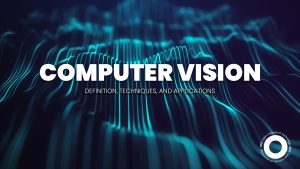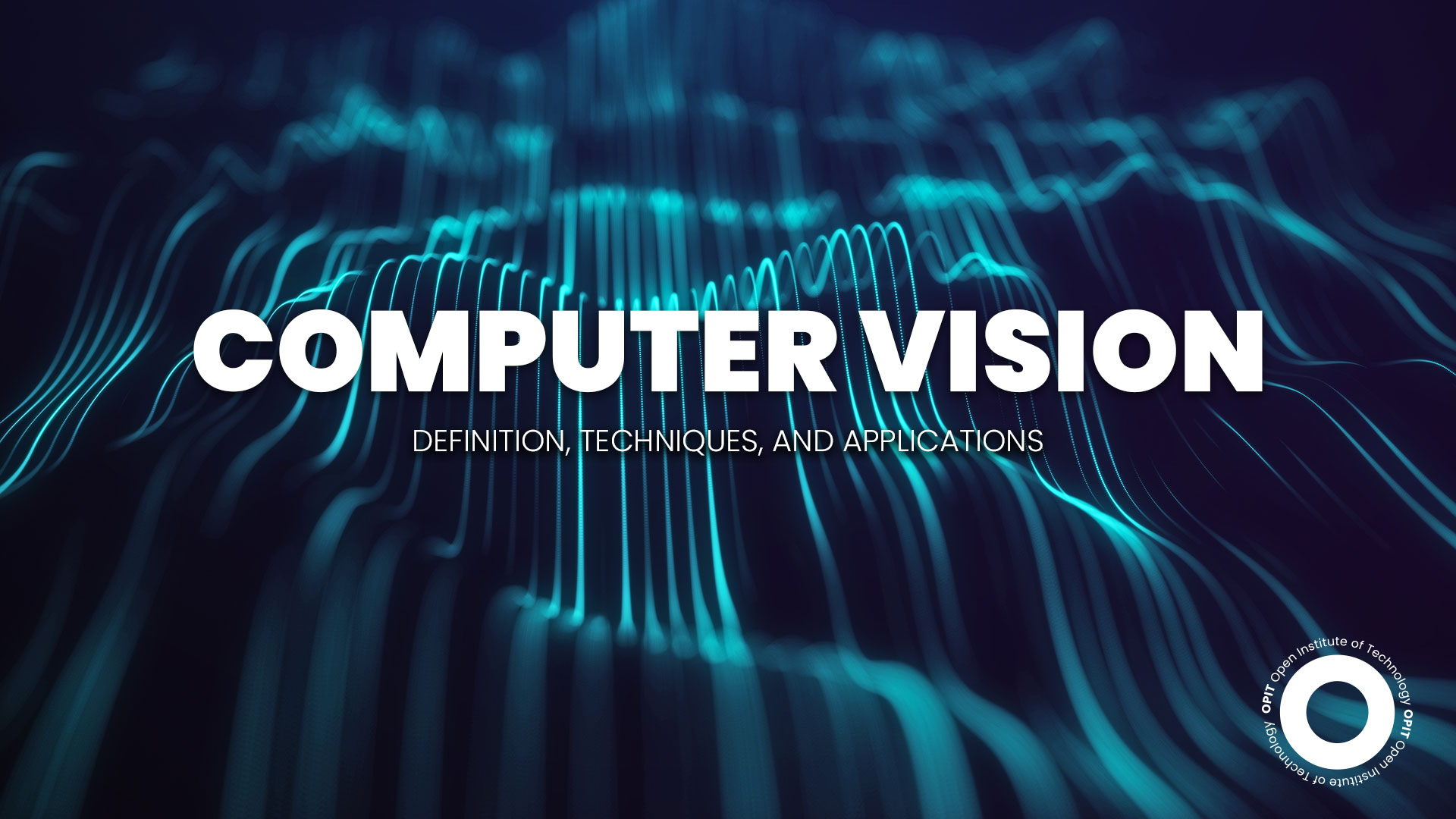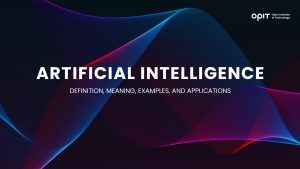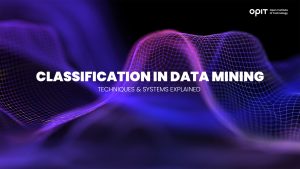

For most people, identifying objects surrounding them is an easy task.
Let’s say you’re in your office. You can probably casually list objects like desks, computers, filing cabinets, printers, and so on. While this action seems simple on the surface, human vision is actually quite complex.
So, it’s not surprising that computer vision – a relatively new branch of technology aiming to replicate human vision – is equally, if not more, complex.
But before we dive into these complexities, let’s understand the basics – what is computer vision?
Computer vision is an artificial intelligence (AI) field focused on enabling computers to identify and process objects in the visual world. This technology also equips computers to take action and make recommendations based on the visual input they receive.
Simply put, computer vision enables machines to see and understand.
Learning the computer vision definition is just the beginning of understanding this fascinating field. So, let’s explore the ins and outs of computer vision, from fundamental principles to future trends.
History of Computer Vision
While major breakthroughs in computer vision have occurred relatively recently, scientists have been training machines to “see” for over 60 years.
To do the math – the research on computer vision started in the late 1950s.
Interestingly, one of the earliest test subjects wasn’t a computer. Instead, it was a cat! Scientists used a little feline helper to examine how their nerve cells respond to various images. Thanks to this experiment, they concluded that detecting simple shapes is the first stage in image processing.
As AI emerged as an academic field of study in the 1960s, a decade-long quest to help machines mimic human vision officially began.
Since then, there have been several significant milestones in computer vision, AI, and deep learning. Here’s a quick rundown for you:
- 1970s – Computer vision was used commercially for the first time to help interpret written text for the visually impaired.
- 1980s – Scientists developed convolutional neural networks (CNNs), a key component in computer vision and image processing.
- 1990s – Facial recognition tools became highly popular, thanks to a shiny new thing called the internet. For the first time, large sets of images became available online.
- 2000s – Tagging and annotating visual data sets were standardized.
- 2010s – Alex Krizhevsky developed a CNN model called AlexNet, drastically reducing the error rate in image recognition (and winning an international image recognition contest in the process).
Today, computer vision algorithms and techniques are rapidly developing and improving. They owe this to an unprecedented amount of visual data and more powerful hardware.
Thanks to these advancements, 99% accuracy has been achieved for computer vision, meaning it’s currently more accurate than human vision at quickly identifying visual inputs.
Fundamentals of Computer Vision
New functionalities are constantly added to the computer vision systems being developed. Still, this doesn’t take away from the same fundamental functions these systems share.
Image Acquisition and Processing
Without visual input, there would be no computer vision. So, let’s start at the beginning.
The image acquisition function first asks the following question: “What imaging device is used to produce the digital image?”
Depending on the device, the resulting data can be a 2D, 3D image, or an image sequence. These images are then processed, allowing the machine to verify whether the visual input contains satisfying data.
Feature Extraction and Representation
The next question then becomes, “What specific features can be extracted from the image?”
By features, we mean measurable pieces of data unique to specific objects in the image.
Feature extraction focuses on extracting lines and edges and localizing interest points like corners and blobs. To successfully extract these features, the machine breaks the initial data set into more manageable chunks.
Object Recognition and Classification
Next, the computer vision system aims to answer: “What objects or object categories are present in the image, and where are they?”
This interpretive technique recognizes and classifies objects based on large amounts of pre-learned objects and object categories.
Image Segmentation and Scene Understanding
Besides observing what is in the image, today’s computer vision systems can act based on those observations.
In image segmentation, computer vision algorithms divide the image into multiple regions and examine the relevant regions separately. This allows them to gain a full understanding of the scene, including the spatial and functional relationships between the present objects.
Motion Analysis and Tracking
Motion analysis studies movements in a sequence of digital images. This technique correlates to motion tracking, which follows the movement of objects of interest. Both techniques are commonly used in manufacturing for monitoring machinery.
Key Techniques and Algorithms in Computer Vision
Computer vision is a fairly complex task. For starters, it needs a huge amount of data. Once the data is all there, the system runs multiple analyses to achieve image recognition.
This might sound simple, but this process isn’t exactly straightforward.
Think of computer vision as a detective solving a crime. What does the detective need to do to identify the criminal? Piece together various clues.
Similarly (albeit with less danger), a computer vision model relies on colors, shapes, and patterns to piece together an object and identify its features.
Let’s discuss the techniques and algorithms this model uses to achieve its end result.
Convolutional Neural Networks (CNNs)
In computer vision, CNNs extract patterns and employ mathematical operations to estimate what image they’re seeing. And that’s all there really is to it. They continue performing the same mathematical operation until they verify the accuracy of their estimate.
Deep Learning and Transfer Learning
The advent of deep learning removed many constraints that prevented computer vision from being widely used. On top of that, (and luckily for computer scientists!), it also eliminated all the tedious manual work.
Essentially, deep learning enables a computer to learn about visual data independently. Computer scientists only need to develop a good algorithm, and the machine will take care of the rest.
Alternatively, computer vision can use a pre-trained model as a starting point. This concept is known as transfer learning.
Edge Detection and Feature Extraction Techniques
Edge detection is one of the most prominent feature extraction techniques.
As the name suggests, it can identify the boundaries of an object and extract its features. As always, the ultimate goal is identifying the object in the picture. To achieve this, edge detection uses an algorithm that identifies differences in pixel brightness (after transforming the data into a grayscale image).
Optical Flow and Motion Estimation
Optical flow is a computer vision technique that determines how each point of an image or video sequence is moving compared to the image plane. This technique can estimate how fast objects are moving.
Motion estimation, on the other hand, predicts the location of objects in subsequent frames of a video sequence.
These techniques are used in object tracking and autonomous navigation.
Image Registration and Stitching
Image registration and stitching are computer vision techniques used to combine multiple images. Image registration is responsible for aligning these images, while image stitching overlaps them to produce a single image. Medical professionals use these techniques to track the progress of a disease.
Applications of Computer Vision
Thanks to many technological advances in the field, computer vision has managed to surpass human vision in several regards. As a result, it’s used in various applications across multiple industries.
Robotics and Automation
Improving robotics was one of the original reasons for developing computer vision. So, it isn’t surprising this technique is used extensively in robotics and automation.
Computer vision can be used to:
- Control and automate industrial processes
- Perform automatic inspections in manufacturing applications
- Identify product and machine defects in real time
- Operate autonomous vehicles
- Operate drones (and capture aerial imaging)
Security and Surveillance
Computer vision has numerous applications in video surveillance, including:
- Facial recognition for identification purposes
- Anomaly detection for spotting unusual patterns
- People counting for retail analytics
- Crowd monitoring for public safety
Healthcare and Medical Imaging
Healthcare is one of the most prominent fields of computer vision applications. Here, this technology is employed to:
- Establish more accurate disease diagnoses
- Analyze MRI, CAT, and X-ray scans
- Enhance medical images interpreted by humans
- Assist surgeons during surgery
Entertainment and Gaming
Computer vision techniques are highly useful in the entertainment industry, supporting the creation of visual effects and motion capture for animation.
Good news for gamers, too – computer vision aids augmented and virtual reality in creating the ultimate gaming experience.
Retail and E-Commerce
Self-check-out points can significantly enhance the shopping experience. And guess what can help establish them? That’s right – computer vision. But that’s not all. This technology also helps retailers with inventory management, allowing quicker detection of out-of-stock products.
In e-commerce, computer vision facilitates visual search and product recommendation, streamlining the (often frustrating) online purchasing process.
Challenges and Limitations of Computer Vision
There’s no doubt computer vision has experienced some major breakthroughs in recent years. Still, no technology is without flaws.
Here are some of the challenges that computer scientists hope to overcome in the near future:
- The data for training computer vision models often lack in quantity or quality.
- There’s a need for more specialists who can train and monitor computer vision models.
- Computers still struggle to process incomplete, distorted, and previously unseen visual data.
- Building computer vision systems is still complex, time-consuming, and costly.
- Many people have privacy and ethical concerns surrounding computer vision, especially for surveillance.
Future Trends and Developments in Computer Vision
As the field of computer vision continues to develop, there should be no shortage of changes and improvements.
These include integration with other AI technologies (such as neuro-symbolic and explainable AI), which will continue to evolve as developing hardware adds new capabilities and capacities that enhance computer vision. Each advancement brings with it the opportunity for other industries (and more complex applications). Construction gives us a good example, as computer vision takes us away from the days of relying on hard hats and signage, moving us toward a future in which computers can actively detect, and alert site foremen too, unsafe behavior.
The Future Looks Bright for Computer Vision
Computer vision is one of the most remarkable concepts in the world of deep learning and artificial intelligence. This field will undoubtedly continue to grow at an impressive speed, both in terms of research and applications.
Are you interested in further research and professional development in this field? If yes, consider seeking out high-quality education in computer vision.
Related posts

Source:
- Agenda Digitale, published on November 25th, 2025
In recent years, the word ” sustainability ” has become a firm fixture in the corporate lexicon. However, simply “doing no harm” is no longer enough: the climate crisis , social inequalities , and the erosion of natural resources require a change of pace. This is where the net-positive paradigm comes in , a model that isn’t content to simply reduce negative impacts, but aims to generate more social and environmental value than is consumed.
This isn’t about philanthropy, nor is it about reputational makeovers: net-positive is a strategic approach that intertwines economics, technology, and corporate culture. Within this framework, digitalization becomes an essential lever, capable of enabling regenerative models through circular platforms and exponential technologies.
Blockchain, AI, and IoT: The Technological Triad of Regeneration
Blockchain, Artificial Intelligence, and the Internet of Things represent the technological triad that makes this paradigm shift possible. Each addresses a critical point in regeneration.
Blockchain guarantees the traceability of material flows and product life cycles, allowing a regenerated dress or a bottle collected at sea to tell their story in a transparent and verifiable way.
Artificial Intelligence optimizes recovery and redistribution chains, predicting supply and demand, reducing waste and improving the efficiency of circular processes .
Finally, IoT enables real-time monitoring, from sensors installed at recycling plants to sharing mobility platforms, returning granular data for quick, informed decisions.
These integrated technologies allow us to move beyond linear vision and enable systems in which value is continuously regenerated.
New business models: from product-as-a-service to incentive tokens
Digital regeneration is n’t limited to the technological dimension; it’s redefining business models. More and more companies are adopting product-as-a-service approaches , transforming goods into services: from technical clothing rentals to pay-per-use for industrial machinery. This approach reduces resource consumption and encourages modular design, designed for reuse.
At the same time, circular marketplaces create ecosystems where materials, components, and products find new life. No longer waste, but input for other production processes. The logic of scarcity is overturned in an economy of regenerated abundance.
To complete the picture, incentive tokens — digital tools that reward virtuous behavior, from collecting plastic from the sea to reusing used clothing — activate global communities and catalyze private capital for regeneration.
Measuring Impact: Integrated Metrics for Net-Positiveness
One of the main obstacles to the widespread adoption of net-positive models is the difficulty of measuring their impact. Traditional profit-focused accounting systems are not enough. They need to be combined with integrated metrics that combine ESG and ROI, such as impact-weighted accounting or innovative indicators like lifetime carbon savings.
In this way, companies can validate the scalability of their models and attract investors who are increasingly attentive to financial returns that go hand in hand with social and environmental returns.
Case studies: RePlanet Energy, RIFO, and Ogyre
Concrete examples demonstrate how the combination of circular platforms and exponential technologies can generate real value. RePlanet Energy has defined its Massive Transformative Purpose as “Enabling Regeneration” and is now providing sustainable energy to Nigerian schools and hospitals, thanks in part to transparent blockchain-based supply chains and the active contribution of employees. RIFO, a Tuscan circular fashion brand, regenerates textile waste into new clothing, supporting local artisans and promoting workplace inclusion, with transparency in the production process as a distinctive feature and driver of loyalty. Ogyre incentivizes fishermen to collect plastic during their fishing trips; the recovered material is digitally tracked and transformed into new products, while the global community participates through tokens and environmental compensation programs.
These cases demonstrate how regeneration and profitability are not contradictory, but can actually feed off each other, strengthening the competitiveness of businesses.
From Net Zero to Net Positive: The Role of Massive Transformative Purpose
The crucial point lies in the distinction between sustainability and regeneration. The former aims for net zero, that is, reducing the impact until it is completely neutralized. The latter goes further, aiming for a net positive, capable of giving back more than it consumes.
This shift in perspective requires a strong Massive Transformative Purpose: an inspiring and shared goal that guides strategic choices, preventing technology from becoming a sterile end. Without this level of intentionality, even the most advanced tools risk turning into gadgets with no impact.
Regenerating business also means regenerating skills to train a new generation of professionals capable not only of using technologies but also of directing them towards regenerative business models. From this perspective, training becomes the first step in a transformation that is simultaneously cultural, economic, and social.
The Regenerative Future: Technology, Skills, and Shared Value
Digital regeneration is not an abstract concept, but a concrete practice already being tested by companies in Europe and around the world. It’s an opportunity for businesses to redefine their role, moving from mere economic operators to drivers of net-positive value for society and the environment.
The combination of blockchain, AI, and IoT with circular product-as-a-service models, marketplaces, and incentive tokens can enable scalable and sustainable regenerative ecosystems. The future of business isn’t just measured in terms of margins, but in the ability to leave the world better than we found it.

Source:
- Raconteur, published on November 06th, 2025
Many firms have conducted successful Artificial Intelligence (AI) pilot projects, but scaling them across departments and workflows remains a challenge. Inference costs, data silos, talent gaps and poor alignment with business strategy are just some of the issues that leave organisations trapped in pilot purgatory. This inability to scale successful experiments means AI’s potential for improving enterprise efficiency, decision-making and innovation isn’t fully realised. So what’s the solution?
Although it’s not a magic bullet, an AI operating model is really the foundation for scaling pilot projects up to enterprise-wide deployments. Essentially it’s a structured framework that defines how the organisation develops, deploys and governs AI. By bringing together infrastructure, data, people, and governance in a flexible and secure way, it ensures that AI delivers value at scale while remaining ethical and compliant.
“A successful AI proof-of-concept is like building a single race car that can go fast,” says Professor Yu Xiong, chair of business analytics at the UK-based Surrey Business School. “An efficient AI technology operations model, however, is the entire system – the processes, tools, and team structures – for continuously manufacturing, maintaining, and safely operating an entire fleet of cars.”
But while the importance of this framework is clear, how should enterprises establish and embed it?
“It begins with a clear strategy that defines objectives, desired outcomes, and measurable success criteria, such as model performance, bias detection, and regulatory compliance metrics,” says Professor Azadeh Haratiannezhadi, co-founder of generative AI company Taktify and professor of generative AI in cybersecurity at OPIT – the Open Institute of Technology.
Platforms, tools and MLOps pipelines that enable models to be deployed, monitored and scaled in a safe and efficient way are also essential in practical terms.
“Tools and infrastructure must also be selected with transparency, cost, and governance in mind,” says Efrain Ruh, continental chief technology officer for Europe at Digitate. “Crucially, organisations need to continuously monitor the evolving AI landscape and adapt their models to new capabilities and market offerings.”
An open approach
The most effective AI operating models are also founded on openness, interoperability and modularity. Open source platforms and tools provide greater control over data, deployment environments and costs, for example. These characteristics can help enterprises to avoid vendor lock-in, successfully align AI to business culture and values, and embed it safely into cross-department workflows.
“Modularity and platformisation…avoids building isolated ‘silos’ for each project,” explains professor Xiong. “Instead, it provides a shared, reusable ‘AI platform’ that integrates toolchains for data preparation, model training, deployment, monitoring, and retraining. This drastically improves efficiency and reduces the cost of redundant work.”
A strong data strategy is equally vital for ensuring high-quality performance and reducing bias. Ideally, the AI operating model should be cloud and LLM agnostic too.
“This allows organisations to coordinate and orchestrate AI agents from various sources, whether that’s internal or 3rd party,” says Babak Hodjat, global chief technology officer of AI at Cognizant. “The interoperability also means businesses can adopt an agile iterative process for AI projects that is guided by measuring efficiency, productivity, and quality gains, while guaranteeing trust and safety are built into all elements of design and implementation.”
A robust AI operating model should feature clear objectives for compliance, security and data privacy, as well as accountability structures. Richard Corbridge, chief information officer of Segro, advises organisations to: “Start small with well-scoped pilots that solve real pain points, then bake in repeatable patterns, data contracts, test harnesses, explainability checks and rollback plans, so learning can be scaled without multiplying risk. If you don’t codify how models are approved, deployed, monitored and retired, you won’t get past pilot purgatory.”
Of course, technology alone can’t drive successful AI adoption at scale: the right skills and culture are also essential for embedding AI across the enterprise.
“Multidisciplinary teams that combine technical expertise in AI, security, and governance with deep business knowledge create a foundation for sustainable adoption,” says Professor Haratiannezhadi. “Ongoing training ensures staff acquire advanced AI skills while understanding associated risks and responsibilities.”
Ultimately, an AI operating model is the playbook that enables an enterprise to use AI responsibly and effectively at scale. By drawing together governance, technological infrastructure, cultural change and open collaboration, it supports the shift from isolated experiments to the kind of sustainable AI capability that can drive competitive advantage.
In other words, it’s the foundation for turning ambition into reality, and finally escaping pilot purgatory for good.
Have questions?
Visit our FAQ page or get in touch with us!
Write us at +39 335 576 0263
Get in touch at hello@opit.com
Talk to one of our Study Advisors
We are international
We can speak in:


